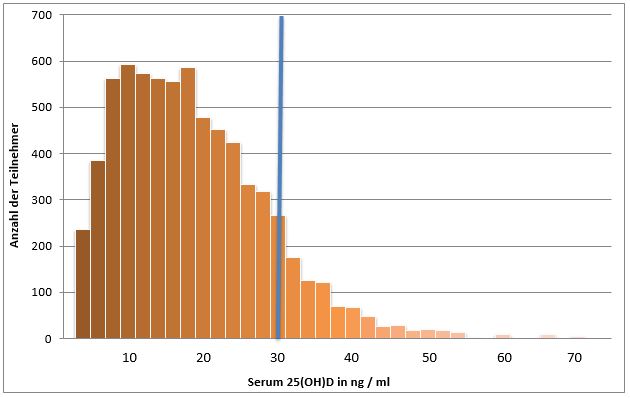Vitamin D
A 2015 publication by the Robert Koch Institute (RKI) also shows a large shift in values in the area of vitamin D deficiency.5 If the reference value of 30 ng/ml is applied to these results, only just under 12 % of the representatively selected adult citizens in Germany have a regular vitamin D level in the period from 2008 to 2011 (see figure).
Based on a threshold value of 30 ng/ml vitamin D, a deficiency is found in almost 90 % of the adult German citizens in a representative collective of the Robert Koch Institute.1
Other publications also confirm this situation: already in the years between 1997 and 1999, 23.6% of German women and 23.7% of men showed a vitamin D deficiency (< 20 ng/ml). Between the years 2008 and 2011, the percentage grew to 29.7% in women and to 30.8% in men, corresponding to an increase in deficiency of 25% in women and 30% in men.2
1 Rabenberg, Martina; Scheidt-Nave, Christa; Busch, Markus A.; Rieckmann, Nina; Hintzpeter, Birte; Mensink, Gert B. M. (2015): Vitamin D status among adults in Germany--results from the German Health Interview and Examination Survey for Adults (DEGS1). In: BMC public health 15, p. 641. doi: 10.1186/s12889-015-2016-7. | 2 S Mehany , C Pöppelmeyer, N Cvjetkovic, N Barkhordarian, O Prochazka, K Buchinger, O Helk, B Wessner, H Klinglmayer, G Schwarz, O Pachinger, K Widhalm. Low vitamin D blood levels in Viennese school children: EDDY study, Aktuel Ernahrungsmed 2015; 40 - P2_3. DOI: 10.1055/s-0035-1550200.
Why is vitamin D so important for the body?
Gene regulation and cell development
Almost all cells in our body contain vitamin D receptors. Vitamin D, which is actually a hormone, binds to these receptors. In this way, it regulates the formation of proteins, enzymes and messenger substances in the body. It is also involved in cell maturation and cell differentiation (= the formation of the task that the cell will later take on).
Immune system and inflammation
Vitamin D inhibits the formation of a signal substance of the immune system (TNF-α). This signal substance is involved in many inflammatory processes. Vitamin D also reduces other inflammatory parameters such as the so-called C-reactive protein or interleukin-6.
Furthermore, vitamin D is necessary for the formation of natural killer cells. These cells are able to recognize and kill virus-infected cells. In addition, vitamin D regulates the immune system's response to foreign organisms or substances.
Bones and teeth
Vitamin D is essential for normal bone formation. It increases the absorption of calcium from food and promotes the storage of calcium (and other minerals) in the bones. The same is true for our teeth.
Furthermore, vitamin D is involved in nerve metabolism and has a protective function for the cardiovascular system.
Vitamin D is the only vitamin in which the biologically active form is a hormone.
The name "vitamin D" refers to a group of related compounds. Vitamin D3, also called cholecalciferol, is the form of vitamin D that our skin synthesizes from cholesterol when exposed to the sun (UV-B). The activation of vitamin D3 occurs in the liver, and further conversion to calcitriol occurs in the kidney. Calcitriol is the most effective form of vitamin D.
It ensures the absorption of calcium from the intestine and kidney and the incorporation of calcium into the bone matrix. Cholecalciferol (also known as cholecalciferol or calciol for short) is the most important physiological form of vitamin D in humans.
Identification of vitamin D deficiency
Our organism converts vitamin D3 in the liver into the intermediate 25-OH vitamin D3, which also bears the designation 25(OH)D. This biomolecule remains constant in the blood over a longer period of time and serves as a storage form of vitamin D. For this reason, it is well suited for diagnosing a vitamin D3 deficiency.
A laboratory determines the concentration of 25-OH vitamin D3 from blood serum. It is expressed either in nanograms per milliliter (ng/ml) or nanomoles per liter (nmol/l). The following results are possible with the measurement:
Translated with www.DeepL.com/Translator (free version)
Overview of 25(OH)D levels in blood serum1
- extreme deficiency: less than 7 ng/ml (17.5 nmol/l)
Deficiency: less than 20 ng/ml (less than 50 nmol/l)
deficiency: 20 to 29 ng/ml (50 to 72.5 nmol/l)
normal values: 30 to 59 ng/ml (75 to 147.5 nmol/l)
high values: 60 to 89 ng/ml (150 to 222.5 nmol/l)
oversupply: 90 to 149 ng/ml (225 to 372.5 nmol/l)
Vitamin D intoxication: over 150 ng/ml (more than 375 nmol/l)
Measured values of 30 to 59 ng/ml are considered normal. Slightly lower values between 20 and 29 ng/ml are called undersupply by medical experts. Vitamin D deficiency is when the 25(OH)D level in the blood falls below 20 ng/ml. This classification is the same for children and adults.
[1] Kipshoven C. Cross-sectional study to estimate vitamin D status in the German population.
Note
Chronic liver and gallbladder disease, as well as other digestive tract disorders in which fats are poorly absorbed, also reduce the absorption and storage of vitamin D. In people with kidney disease, the conversion of vitamin D to its active form calcitriol is reduced; likewise, the kidney increasingly loses the ability to convert vitamin D3 to its active form with age. The skin is also much less efficient at producing vitamin D3 with age.
Certain drugs used in epileptics can accelerate the breakdown of vitamin D. The same effect is seen in certain medications. The same effect is produced by certain drugs that are often used in cancer patients (cytostatics). Cortisone, which is used in inflammatory diseases, lowers the vitamin D level, among other things, which increases the vitamin D requirement while taking cortisone.
Vitamin D - endogenous production
How much sun does the body need to produce sufficient vitamin D via the body's own formation? How is this in autumn and winter compared to summer?
The body's own vitamin D formation in the skin through sunlight (UVB rays) depends on latitude, time of year and day, weather, clothing, length of time spent outdoors, as well as skin type and also the use of sunscreens, which reduce the body's own production. This means that the contribution of the body's own production to the vitamin D supply can vary greatly from individual to individual. Thus, the endogenous contribution to vitamin D supply cannot be quantified for individuals, nor can it be determined in general for the general population.
In the summer months, it is possible to achieve the desired serum concentration of 25-hydroxyvitamin D of 50 nmol/l through endogenous formation. The endogenous formation through sunlight irradiation depends on the geographical location. The following table gives orientation values for the duration of sunlight irradiation for a good vitamin D supply for latitudes 50 to 75 N°.
As Austria ranges from 47 to 49 N° (latitude), it should be sufficient for about half of the year for adults to expose about a quarter of the body surface (face, hands and parts of arms and legs) to the sun for 5 to 25 minutes per day between 12 noon and 3 p.m., depending on skin type and season.
| Duration of sunlight exposure for skin type I/II (light to very light skin color, light red or blond hair, blue or green eyes). | Duration of sunlight exposure for skin type III (medium skin color, dark hair, brown eyes). | |
| March till May | 10 to 20 minutes | 15 to 25 minutes |
| June till August | 5 to 10 minutes | 10 to 15 minutes |
| September till October | 10 to 20 minutes | 15 to 25 minutes |
In the morning from 10 a.m. to 12 p.m. and in the afternoon from 3 p.m. to 6 p.m., the duration of sunlight exposure can be doubled. In contrast to the summer months, sunlight in Austria is not strong enough in the months from October to March to ensure sufficient vitamin D formation.
Vitamin D3
- supports cell development in various tissues, cell differentiation and healthy cell maturation
- supports the immune system in the formation of natural "killer" cells
- supports the cardiovascular system
- supports normal bone formation
- supports the absorption and utilization of calcium in the bones
- contributes to normal absorption and utilization of calcium and phosphorus
- contributes to the maintenance of normal teeth
- contributes to normal blood calcium levels
Products with vitamin D...
-
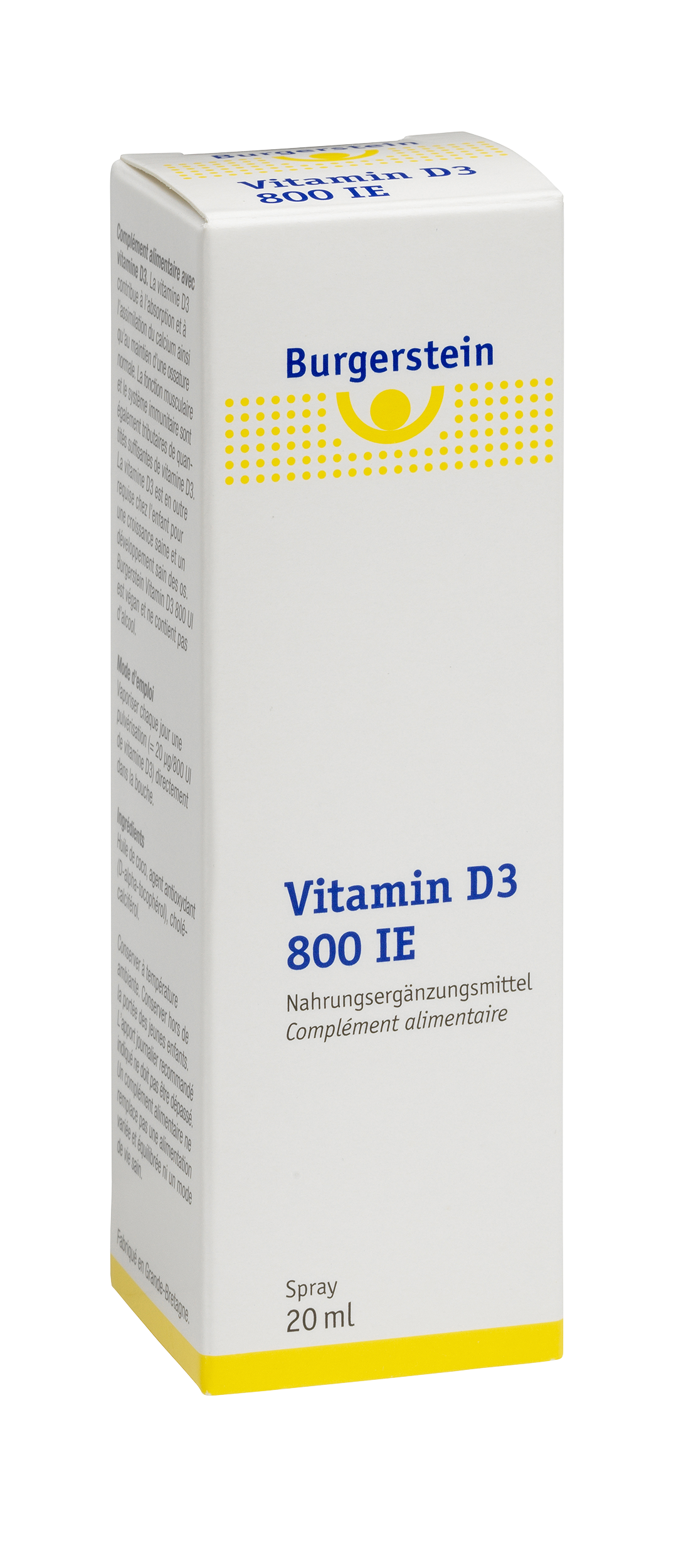
Vitamin D3 800 IE
check product -

Vitamin D3 2.000 IE
check product -
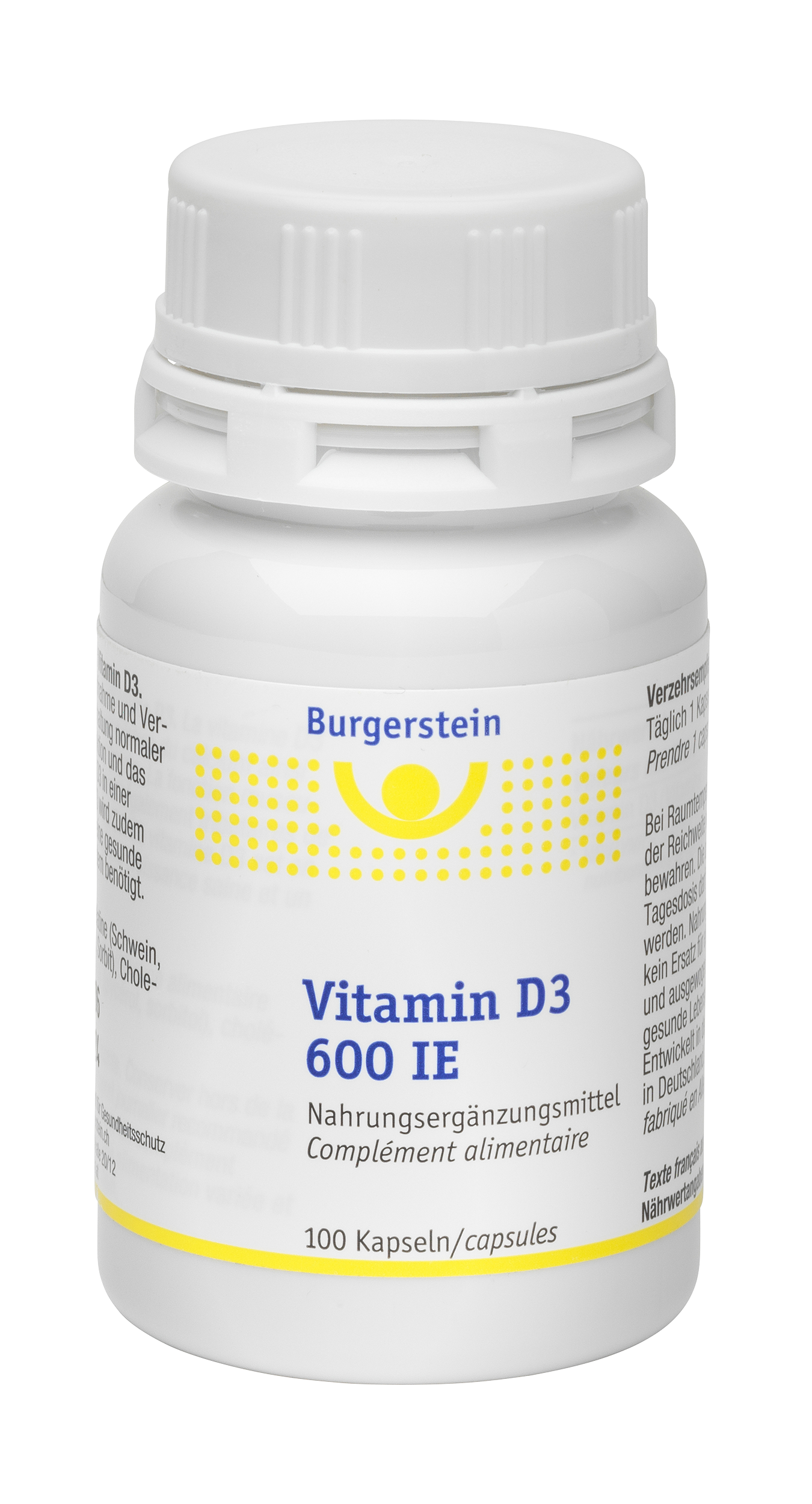
Vitamin D3 600 I.E.
check product -
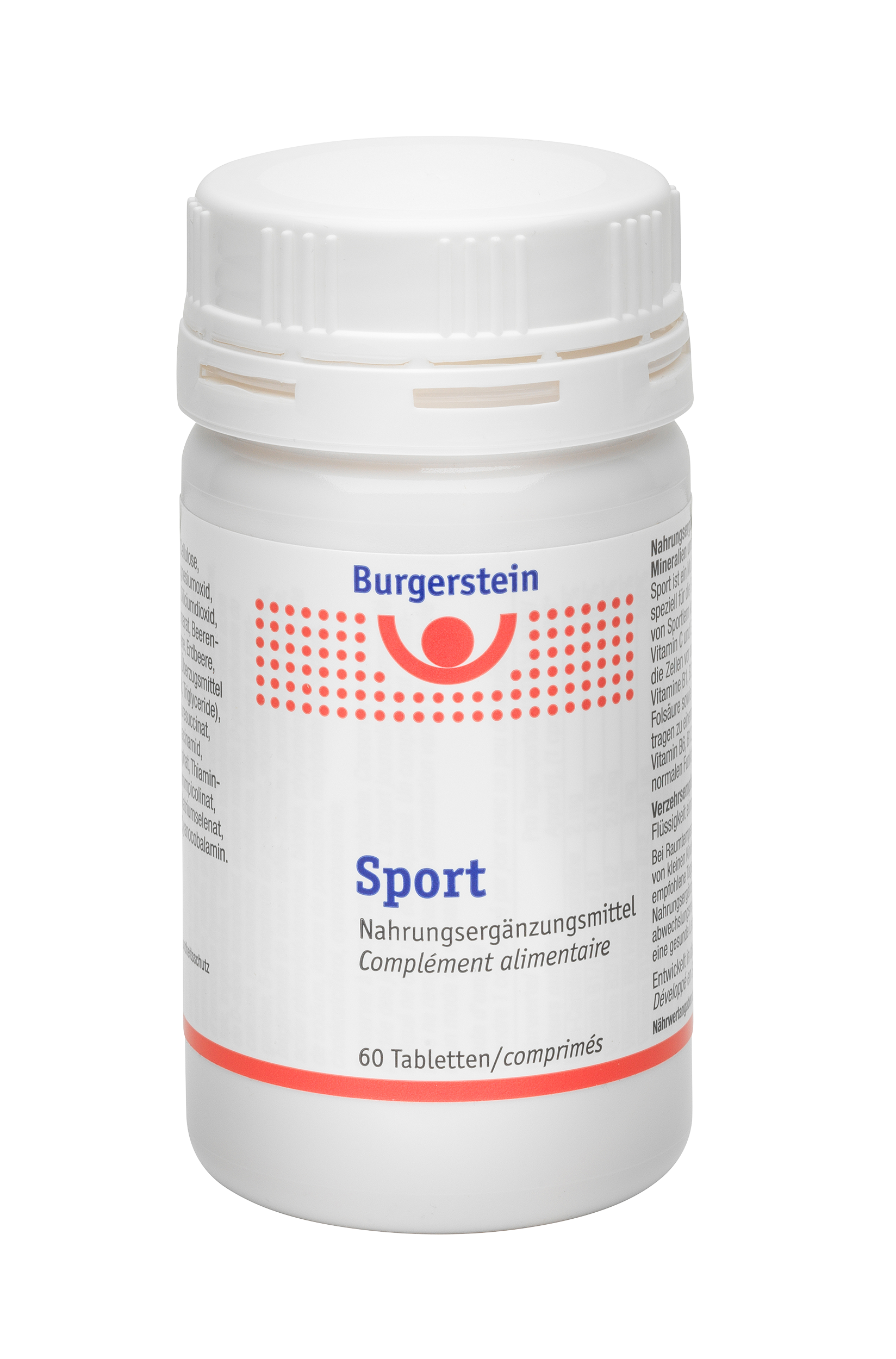
Sport
check product -
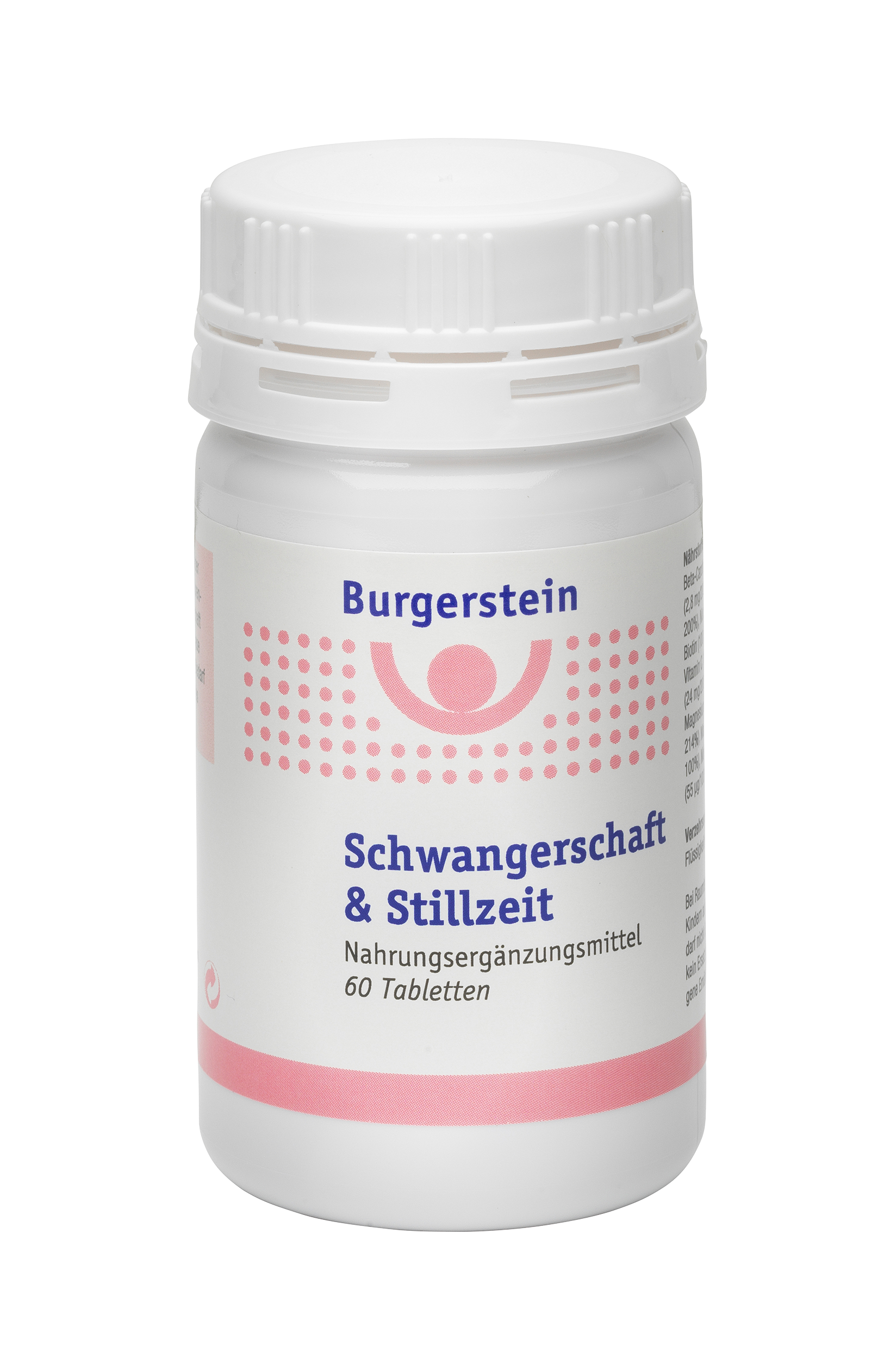
Schwangerschaft & Stillzeit
check product -
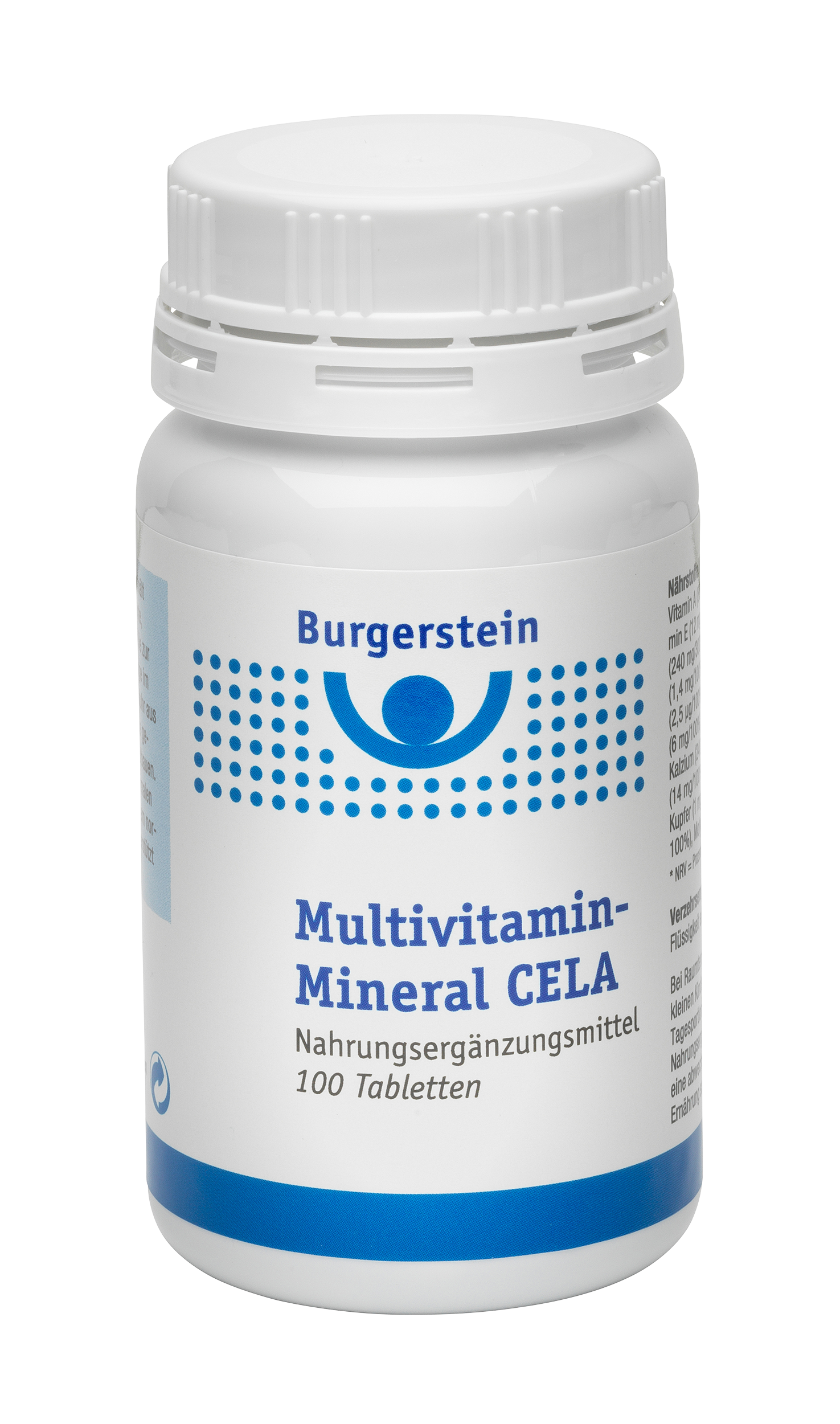
Multivitamin Mineral CELA
check product -
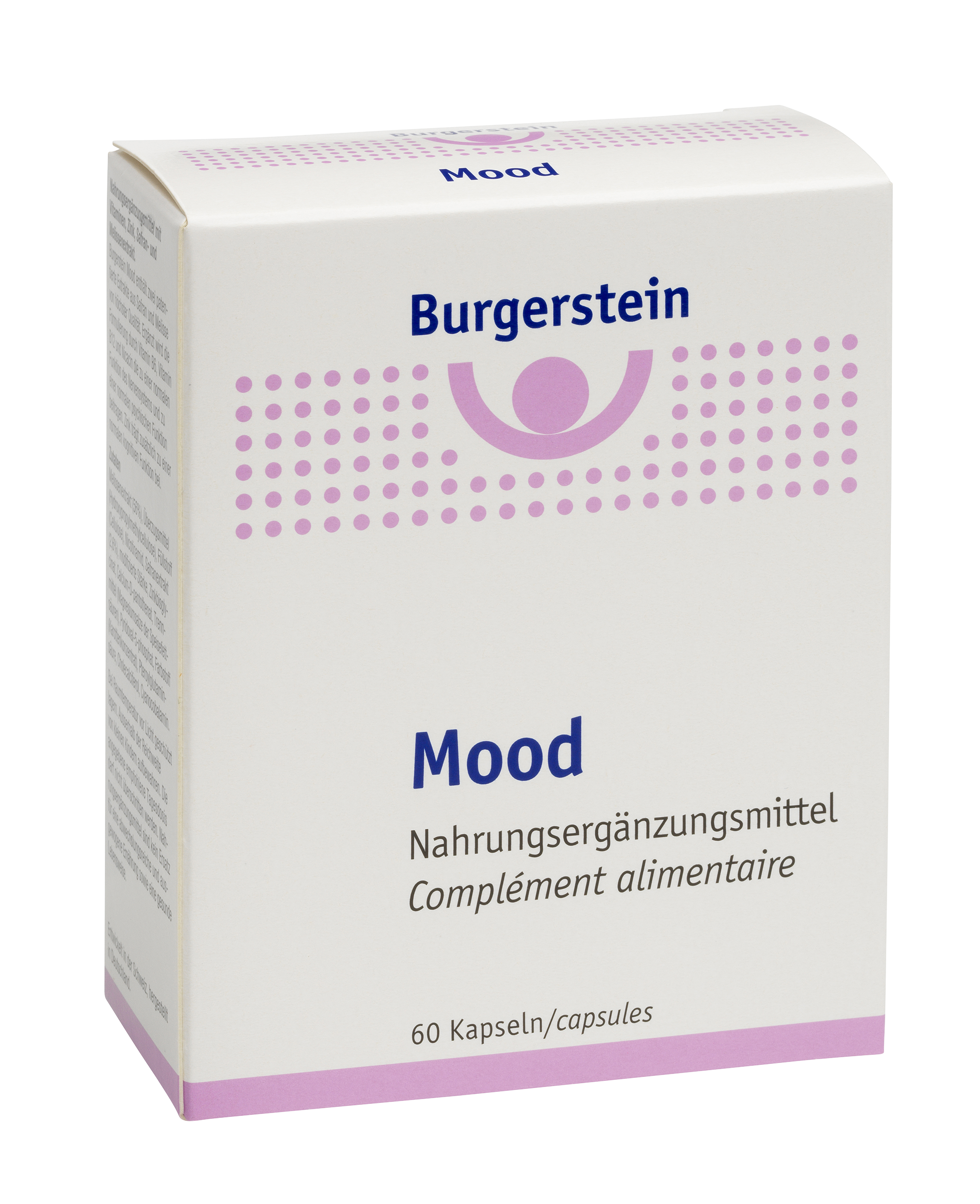
Mood
check product


